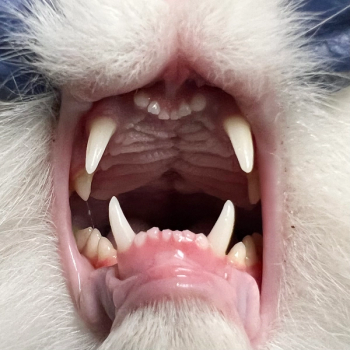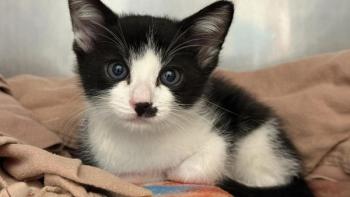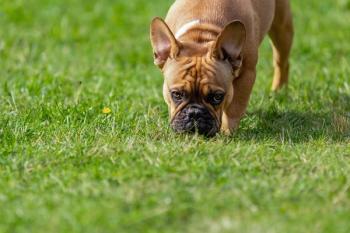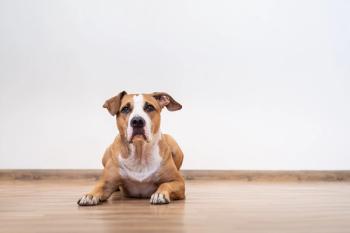
Paw tissues unique; injuries need special care, attention
Dr. Tannaz Amalsadvala focuses on some of the more common paw pad injuries seen in practice as she discusess treatment options for paw pad abrasions and lacerations.
Paw pad injuries observed in dogs run the gamut from abrasions, blisters, ulcers and pressure callus formation, to burns, lacerations and avulsions accompanying distal limb degloving injuries. The canine footpad is a highly specialized tissue with specific and distinctive functions, and therefore, cannot be replaced by skin from the body. Wound management of these injuries is directed toward preserving as much of the pad tissue as possible and keeping pressure off of the affected paw to encourage wound healing, re-epithelialization and epithelial keratinization. This article will discuss management of two types of wounds commonly encountered by veterinary practitioners: paw pad abrasions and lacerations.
Photo 1: Deep pad abrasion with re-epithelialization in process.
Abrasions and burns
The less severe form of abrasion injury results in loss of stratum corneum from a pad. This can result from prolonged contact of the pad with a rough surface, during movement. These wounds are commonly observed in sporting dogs and working dogs. The wound leaves the deeper, more sensitive layers of the epidermis exposed. In the more serious form, the shearing force generated between the two surfaces (pad and ground) strips paw pad epidermis and partial or full thickness dermis. With full thickness skin loss, the underlying fibroadipose tissue of the pad is exposed (Photo 1). Dogs dragged behind motor vehicles have this type of injury. Chemical and thermal, superficial pad burn wounds may present a similar clinical picture with varying loss of epidermis and dermis.
Dogs with the more superficial abrasion injury may have tags or flaps of superficial epidermis over the wound, which should be removed. However, these wounds are generally clean and require little if any debridement or lavage. More severe abrasion injuries with debris embedded in the tissues may require more management. These wounds should be surgically debrided to remove devitalized tissue. They should be lavaged copiously with 0.05 percent chlorhexidine diacetate solution. The lavage solution is expressed through an 18-gauge hypodermic needle attached to a 35-ml syringe. This is usually sufficient to dislodge debris and unattached tissue fragments from within a wound without traumatizing healthy tissue. Prior to bandaging, cotton pledgets may be placed in the interdigital spaces to maintain a dry environment.
Figure 1: Evaluating the depth of a paw laceration (A)Pad laceration does not appear to be deep due to apposition of deep pad tissues. (B) Laceration extends the full thickness of the pad, with contamination of pad tissues and the underlying area, including the flexor tendons. (C and D) Hemostatic forceps placed in the wound and spread to assess the depth of the wound. Credit: Swaim SF, Henderson RA: Small Animal Wound Management, 2nd edition, Williams and Wilkins, Baltimore, 1997, p. 336.
In superficial and deep abrasion and burn injuries, the goal is rapid epithelialization. With the superficial wounds, the tougher superficial epidermal layers are regenerated from the remaining pad epidermis. The deeper, i.e. full thickness skin wounds rely on re-epithelialization with a tough keratinized epithelium derived from intact pad skin at the edge of the wound. Thus, a portion of intact, full thickness pad tissue at the edge of these wounds is necessary for this type of healing. Epithelium derived from haired skin at the periphery of a pad will not suffice for pad replacement.
A protected, moist, nonadherent wound surface devoid of pressure is important to promote rapid re-epithelialization. Topical dressings such as Acemannan hydrogel, silver sulfadiazine cream or a neomycin-bacitracin-polymixin (Neosporin) ointment known epithelialization stimulants, may be sparingly applied to the wound surface. A nonadherent, semiocclusive, primary bandage layer followed by a thick layer of absorbent, secondary bandage wrap and a tertiary, two-inch porous adhesive tape layer, complete the bandage. If there is concern about the bandage causing pressure over the carpal pad or the point of hock, a modified "donut" bandage made of four to five folds of cotton cast padding material with a hole cut in its center, can be placed over the carpal pad or the point of the hock and incorporated into the secondary absorbent bandage layer. The cup portion of a Mason metasplint cut to size is incorporated within the bandage under the palmar/plantar surface of the paw, especially with deeper wounds. Initially, daily wound dressing and bandage change is necessary. This assures replacement of active drug on the wound surface.
Bandaging must be continued until the new, delicate epithelium reveals some keratinization. Exercise is restricted up to this point. Subsequently, gradual reintroduction of exercise on a nonabrasive surface may be started. To ease the transition from a bandaged paw to an unbandaged paw, some type of bootie may be considered. Following rekeratinization of the paw pad, a pad toughener may be used topically to aid in resisting normal "wear-and-tear." For superficial abrasions and burns, re-epithelialization may be complete by seven to nine days. With deeper injuries, healing may take up to 21 days, depending on the size of the wound.
Photo 2: Foam pad sponge that will be included in the secondary layer of the bandage. Aperture has been cut to relieve pressure on the wound after it is sutured.
Non-adherent bandage therapy plays a pivotal role in abrasion wound management as it provides an optimum environment for re-epithelialization. Medications that stimulate re-epithelialization and proper bandage padding also enhance abrasion and burn injury healing. Improper bandaging techniques may result in impaired healing.
Paw pad lacerations
Pad laceration is a wound resulting from tearing of pad tissue. Lacerations may be full or partial thickness. Management of such a wound is dictated by the depth and loss of tissue from that wound. Sharp edges on objects, such as glass, metal and occasionally stone and lawn edging are capable of creating such wounds when a dog accidentally steps on them. Most of these are highly contaminated wounds owing to their anatomical location, especially if the dog persists in placing the paw on the ground after wound infliction.
Once the animal is anesthetized, careful wound examination should be performed.
Photo 3: "Clam shell" bandage for maximum pad pressure relief on severe injuries and/or large dogs. Mason metasplints on caudal and cranial bandage surfaces, extending beyond end of paw.
With the blades in the closed position, a pair of sterile, hemostatic forceps is introduced into the wound. The blades are then opened to spread the wound and gauge its depth. This helps assess full thickness or partial thickness involvement of the pad. With full thickness lacerations, digital flexor tendons may be visible (Figure 1, p. 17). The distal limb is routinely prepared for aseptic surgery. The hair on the paw is clipped as far proximal as the distal antebrachium or just proximal to the hock. Special attention is paid to clipping hair within interdigital spaces, followed by a surgical scrub of the area using chlorhexidine scrub. This is followed by followed by surgical debridement of any necrotic tissue and thorough lavage using 0.05 percent chlorhexidine diacetate solution as described in the previous section, to dislodge any dirt and contaminants present. If the wound is a full thickness pad laceration, a 1��4-inch Penrose drain may be placed under the pad tissue, exiting through and anchored to the skin adjacent to the pad (Figure 2). Deep, simple interrupted sutures using absorbable material such as 3-0 polydioxanone or polyglactin 910 should be placed in the fibroadipose tissue of the pad to help appose the deeper layers. The superficial, keratinized layer of the pad tissue is apposed using 3-0 nonabsorbable materials such as polypropylene or nylon in a far-near-near-far suture pattern. This pattern achieves apposition while distributing the tension away from the suture line. Segments of cotton are placed within the interdigital spaces to maintain a dry environment. Nonadherent pad may be used as the primary bandage layer. A modified "donut" bandage, as previously described, may be placed over the carpal pad or the point of hock if there is concern about the bandage placing pressure over these areas. This is incorporated into the secondary, fairly thick, absorbent gauze wrap, followed by a tertiary, porous, two-inch adhesive tape layer. It is important to keep weight off of a sutured paw pad while it heals. One of the two types of bandage can be used for this. First, a "donut" type bandage can be used whereby a foam sponge is cut to shape of the palmar/plantar paw surface, with a hole is cut in the sponge at the area overlying the sutured wound (Photo 2, p. 17). Incorporating this in a bandage distributes pressure around a wound. This could be used on small to medium sized dogs or lacerations that are not severe. For large dogs or major pad wounds, a "clam shell" bandage/splint should be considered. It acts as a localized crutch. After bandage placement, a Mason metasplint is placed on the cranial and caudal bandage surfaces such that they extend by 1 inch beyond the very distal end of the paw, with the cups of the splints facing each other. These are taped to the bandage (Photo 3, p. 17). Short of bandaging the leg up with the stifle joint flexed, the "clam shell" bandage / splint keeps pressure off of the pads most efficiently.
Bandage change is performed daily for the heavily draining wounds and then decreased to every second or third day, depending on the amount of drainage. If a drain has been placed, it is removed between days three and five postoperatively. Sutures are usually removed around day 14 post operatively, however, the bandage is replaced and changed every third day for another seven to 14 days.
Figure 2: Placement of a Penrose drain under a pad (A) Hemostatic forceps placed under a pad via incisions at the pad edges. Forceps grasp a Penrose drain to pull it under the pad. (B) Penrose drain placed under the pad with suture anchors at each end. Credit: Swaim SF, Henderson RA: Small Animal Wound Management, 2nd edition, Williams and Wilkins, Baltimore, 1997, p. 337.
Paw pad lacerations allowed to heal by first intention show earlier increased tensile strength of the pad tissue and decreased scarring when compared to those allowed to heal by second intention. Pads spread when weight is borne on them, causing the fibroelastic dermis to stretch. If lacerations are not sutured and are not bandaged to keep weight off of the tissue, weight bearing spreads the tissue and delays healing. Along the same line, if a sutured wound is not bandaged to keep weight off of the pad, weight bearing causes the pad tissue to spread, the sutures to tear through tissue and therefore, delayed healing.
Paw pad abrasions, burns and lacerations are common paw injuries presented to practicing veterinarians. Due to the uniqueness of paw pad tissue, its injuries are managed differently.
Newsletter
From exam room tips to practice management insights, get trusted veterinary news delivered straight to your inbox—subscribe to dvm360.






